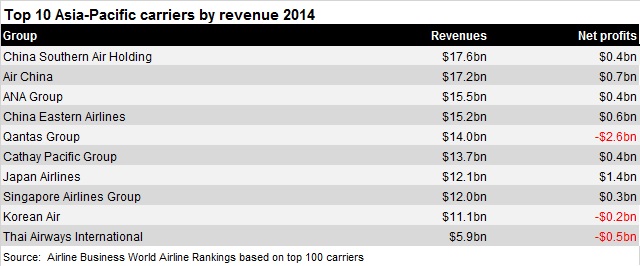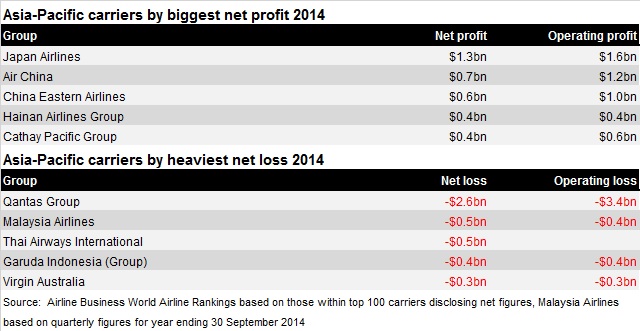Asia-Pacific's leading carriers were again in the black in 2014, though collective profits remain below previous highs as over-capacity, local issues and continued air freight market challenges hit yields for many in the region.
Operating profits reached $3 billion among leading Asia-Pacific carriers, figures covering the top 100 airline in this year's Airline Business World Airline Rankings show.

While this is roughly$1 billion less than in the previous year, the figure is hugely distorted by the around $2 billion non-cash hit Qantas took in fleet write-downs. Likewise this dragged leading Asia-Pacific carriers to a small net loss in 2014, compared with a profit of over $2 billion in 2013
That hit related to restructuring at Qantas, which has successfully turned round its fortunes. The Oneworld carrier returned to profit in its first half and expects to post a profit in its financial year, which closed at the end of June. Its fellow hard-hit compatriot operator, Virgin Australia, also returned to profit in the first half.

There were more strong profits at Japanese pair All Nippon Airways and Japan Airlines, although another Japanese operator, Skymark Airlines, was forced into bankruptcy protection earlier this year. Chinese carriers too helped drive Asia profits in 2014, with a notable improvement at an operating level.
But there have been mixed financial fortunes across Asia. The most high profile has been Malaysia Airlines, which has embarked on a major restructuring after a traumatic 2014 and the tragic loss of two Boeing 777s. New chief Christoph Mueller confirmed the scale of the restructuring – which will cut around 30% of its 20,000 strong workforce – at the start of June, describing the airline as “technically bankrupt”. The airline is hoping its restructuring will return it to profit by 2018.
But it was not alone in suffering. The political uncertainty during 2014 which damaged Thailand’s key tourism industry hit Thai Airways hard and prompted another year of loss and another change in chief executive. Garuda Indonesia too endured a difficult year.
Many of the carriers in the region continue to suffer from the stuttering air cargo market. This has struggled to return to pre-financial crisis highs. Even as traffic has returned, yield improvement has failed to match this - in part because of the extra belly-hold capacity available from new passenger aircraft being added in the region. Asian carriers are more heavily exposed to air cargo because it represent around 40% of the market.
The going was harder too for some of Asia’s low-cost operators. Following heady growth from the likes of Tigerair, AirAsia and Lion Air, most of the region’s budget carriers put the brakes on expansion in a bid to preserve yield and prevent an all-out bloodbath as seen in other markets. This has seen several carriers sell aircraft or defer planned deliveries.
AirAsia remained profitable in 2014, though profits slipped, but it produced an improved first quarter. “One of the main catalysts is a more rational market in Malaysia,” said chief executive Tony Fernandes in May. “Airline operators in general are now a bit more disciplined in their capacity management, setting the stage for a better operating environment in 2015.”
But some of AirAsia’s units struggled, most notably long-haul unit AirAsia X, which racked up heavy losses in 2014 and saw the departure of long-serving chief executive Azran Osman-Rani.
The jockeying for position in the developing low-cost markets through joint venture carriers – from both established budget brands and the network carriers – continues with mixed success so far. While some have established themselves, others have failed or had false dawns, or in the case of still-blocked Qantas-China Eastern part-owned joint venture Jetstar Hong Kong, experienced no dawn at all so far.
Source: Airline Business























